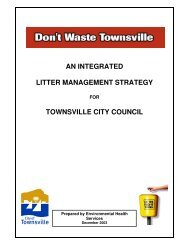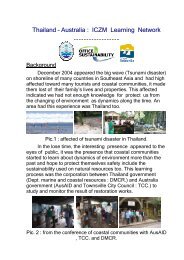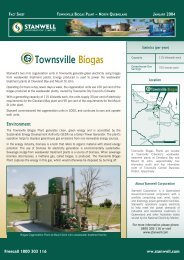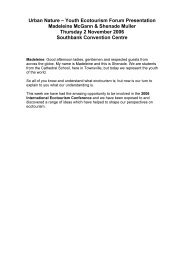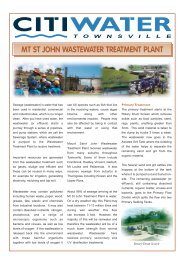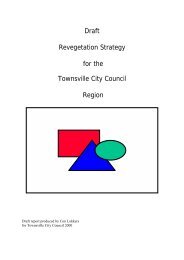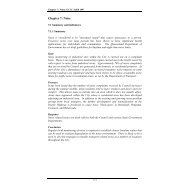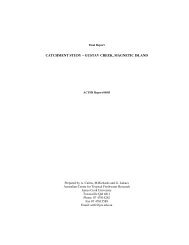ENVI RONMENTAL HI STORY OF ROWES BAY - Townsville State ...
ENVI RONMENTAL HI STORY OF ROWES BAY - Townsville State ...
ENVI RONMENTAL HI STORY OF ROWES BAY - Townsville State ...
- No tags were found...
Create successful ePaper yourself
Turn your PDF publications into a flip-book with our unique Google optimized e-Paper software.
7. Significant Events Affecting Rowes Bay Since 1865Environmental history of Rowes BayThe foreshores of Rowes Bay have been affected by a number of significant events over the past135 years. These have combined to shape the landscape and its process regime as it is seen today.1874-1891: Development of the Port breakwatersFrom 1874 to 1891 the main eastern and western breakwaters were constructed at the Port. Theseextended some 1.5 km out from the shoreline, and have effectively stopped the natural transport ofsand that originally took sediment along the shoreline from Ross River through to The Strand, andaround Kissing Point into Rowes Bay, and subsequently on to Pallarenda. The breakwaters extendout into water depths that are beyond where sand transport can occur. Sand movement along theshore was slow and episodic, so the effects of the Port breakwaters were not seen for many decades.Early 1930s: The last major input of sand around Kissing Point into Rowes BayA pulse of sand passed around Kissing Point into Rowes Bay probably sometime in the early 1930s.This was then slowly moved onshore by wave action, taking up to 20 years to reach the Rowes Bayshoreline. The 1938 aerial photograph shows about 35,000 m 3 of sand spits moving into innerRowes Bay, and by 1952 some 53,000 m 3 had accumulated along north Rowes Bay. Thus this totalsand input was probably about 88,000 m 3 . No large amounts of sand have been naturally added tothe foreshore since that time.1952: Rowes Bay beach at its most advancedThe 1952 aerial photographs show the Rowes Bay foreshore in its most advanced condition everrecorded. Wave processes had worked sand up onto the beach recovering all of the erosion of 1940,and advancing the beach on average ~13 m beyond its 1938 position. This probably represents theshoreline condition after the last of the natural sand supply had been added to the beach.Mid 1950s: Initiation of persistent shoreline erosionThe shoreline erosion phase of the latter part of the 20 th Century began sometime shortly after 1952.This erosion has gradually worked its way northwards along Rowes Bay, as the starvation ofsediment becomes more and more acute. The 1961 aerial photographs also show the north RowesBay beach with a clear erosion scarp. This is the first time this feature has been seen on the beach,and it has been a persistent feature since then. It probably signals the start of the long-term erosiontrend as a result of the cessation of natural sand supply to the foreshore. This is more than 80 yearsafter the sand supply from Ross River was originally interrupted by the construction of the first Portbreakwater in 1874.1961: Construction of One Mile Creek drainThe construction of the One Mile Creek drain completed the radical change to the drainage systemsof Rowes Bay that had begun with the removal of the nearby North Ward Creek and mudflats. Thelower kilometre of Mundy Creek and its estuary have also been almost completely removed fromthe landscape. The One Mile Creek drain was completed at the end of 1961, and subsequently itschannel and mudflats have been reclaimed. The mouth of Mundy Creek had constantly changedposition in response to the movement of sand spits, bars and beaches at the entrance. Similarprocesses have affected One Mile Creek drain and its mouth has required regular re-opening afterbeing blocked by the migration of the beach and sand bars. This is not surprising, as artificialstream channels cut through beaches have almost always required the construction of training wallsto keep them open. A similar process could be considered for One Mile Creek.1971: Cyclone AltheaCyclone Althea has been a very significant event in Rowes Bay, and its effects are still being felt.North Rowes Bay beach was eroded ~13 m, and there was only a brief period of recovery before thelong-term erosion trend set in again.16



